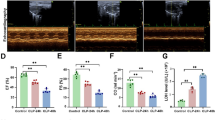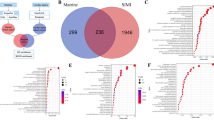Abstract
TBC1 domain family member 25 (TBC1D25) is a crucial mediator of signal transduction involved in the development of several diseases. Particularly, a cardioprotective role of TBC1D25 has been raised due to its antagonistic action on cardiac hypertrophy. However, whether TBC1D25 protects the myocardium from ischemia–reperfusion injury has not been reported. This work aimed to determine the role of TBC1D25 in myocardial ischemia–reperfusion (MIR) injury and to explore the potential mechanisms involved. Marked decreases in TBC1D25 levels occurred in cardiomyocytes suffering hypoxia/reoxygenation (H/R) injury in vitro and myocardium tissues of rats with MIR injury in vivo. Cardiomyocytes overexpressing TBC1D25 were protected from apoptosis and inflammation triggered by H/R, whereas TBC1D25-deficient cardiomyocytes were more sensitive to H/R injury. Intramyocardial injection of recombinant adenovirus expressing TBC1D25 into rats reduced infarct size and cardiac injury triggered by MIR injury accompanied by decreased myocardial apoptosis and inflammation. A subsequent mechanistic investigation revealed that the signaling cascade of transforming growth factor-β–activated kinase 1 (TAK1)-c-Jun N-terminal kinase (JNK)/p38 mitogen-activated protein kinase (MAPK) activated under H/R or MIR conditions was markedly restrained by TBC1D25 overexpression. Moreover, TAK1 blockade remarkably reversed the TBC1D25 deficiency–induced aggravating effect on H/R injury. The work concludes that TBC1D25 protects against MIR injury through action on the TAK1-JNK/p38 MAPK signaling cascade. This work suggests TBC1D25 as a potential therapeutic target for MIR injury.











Similar content being viewed by others
Data availability
The datasets used during the present study are available from the corresponding author on reasonable request.
References
Aashaq S, Batool A, Andrabi KI (2019) TAK1 mediates convergence of cellular signals for death and survival. Apoptosis 24:3–20
Chen C, Yu LT, Cheng BR, Xu JL, Cai Y, Jin JL, Feng RL, Xie L, Qu XY, Li D, Liu J, Li Y, Cui XY, Lu JJ, Zhou K, Lin Q, Wan J (2021a) Promising therapeutic candidate for myocardial ischemia/reperfusion injury: what are the possible mechanisms and roles of phytochemicals? Front Cardiovasc Med 8:792592
Chen SY, Zhang HP, Li J, Shi JH, Tang HW, Zhang Y, Zhang JK, Wen PH, Wang ZH, Shi XY, He YT, Hu BW, Yang H, Guo WZ, Zhang SJ (2021b) Tripartite motif-containing 27 attenuates liver ischemia/reperfusion injury by suppressing transforming growth factor beta-activated kinase 1 (TAK1) by TAK1 binding protein 2/3 degradation. Hepatology 73:738–758
Dong L, Shen Z, Chi H, Wang Y, Shi Z, Fang H, Yang Y, Rong J (2023) Research progress of Chinese medicine in the treatment of myocardial ischemia-reperfusion injury. Am J Chin Med 51:1–17
Gabernet-Castello C, O’Reilly AJ, Dacks JB, Field MC (2013) Evolution of Tre-2/Bub2/Cdc16 (TBC) Rab GTPase-activating proteins. Mol Biol Cell 24:1574–1583
Guo S, Liu Y, Gao L, Xiao F, Shen J, Xing S, Yang F, Zhang W, Shi Q, Li Y, Zhao L (2020) TBC1D25 regulates cardiac remodeling through TAK1 signaling pathway. Int J Biol Sci 16:1335–1348
He J, Liu D, Zhao L, Zhou D, Rong J, Zhang L, Xia Z (2022) Myocardial ischemia/reperfusion injury: mechanisms of injury and implications for management (Review). Exp Ther Med 23:430
Heusch G (2020) Myocardial ischaemia-reperfusion injury and cardioprotection in perspective. Nat Rev Cardiol 17:773–789
Hirano S, Uemura T, Annoh H, Fujita N, Waguri S, Itoh T, Fukuda M (2016) Differing susceptibility to autophagic degradation of two LC3-binding proteins: SQSTM1/p62 and TBC1D25/OATL1. Autophagy 12:312–326
Itoh T, Kanno E, Uemura T, Waguri S, Fukuda M (2011) OATL1, a novel autophagosome-resident Rab33B-GAP, regulates autophagosomal maturation. J Cell Biol 192:839–853
Komal S, Komal N, Mujtaba A, Wang SH, Zhang LR, Han SN (2022) Potential therapeutic strategies for myocardial infarction: the role of Toll-like receptors. Immunol Res 70:607–623
Li J, Yan C, Wang Y, Chen C, Yu H, Liu D, Huang K, Han Y (2022) GCN5-mediated regulation of pathological cardiac hypertrophy via activation of the TAK1-JNK/p38 signaling pathway. Cell Death Dis 13:421
Nawaz S, Hussain S, Basit S, Ahmad W (2021) First evidence of involvement of TBC1D25 in causing human male infertility. Eur J Med Genet 64:104142
Roy M, Stephens E, Bouhour S, Roux S (2021) RabGAP TBC1D25 is involved in human osteoclast activity. Eur J Cell Biol 100:151145
Saito Y, Oyama K, Tsujita K, Yasuda S, Kobayashi Y (2023) Treatment strategies of acute myocardial infarction: updates on revascularization, pharmacological therapy, and beyond. J Cardiol 81:168–178
Tao Q, Tianyu W, Jiangqiao Z, Zhongbao C, Xiaoxiong M, Long Z, Jilin Z (2019) Tripartite motif 8 deficiency relieves hepatic ischaemia/reperfusion injury via TAK1-dependent signalling pathways. Int J Biol Sci 15:1618–1629
Tsao CW, Aday AW, Almarzooq ZI, Anderson CAM, Arora P, Avery CL, Baker-Smith CM, Beaton AZ, Boehme AK, Buxton AE, Commodore-Mensah Y, Elkind MSV, Evenson KR, Eze-Nliam C, Fugar S, Generoso G, Heard DG, Hiremath S, Ho JE, Kalani R, Kazi DS, Ko D, Levine DA, Liu J, Ma J, Magnani JW, Michos ED, Mussolino ME, Navaneethan SD, Parikh NI, Poudel R, Rezk-Hanna M, Roth GA, Shah NS, St-Onge MP, Thacker EL, Virani SS, Voeks JH, Wang NY, Wong ND, Wong SS, Yaffe K, Martin SS, American Heart Association Council on E, Prevention Statistics C and Stroke Statistics S (2023) Heart Disease and Stroke Statistics-2023 update: a report from the American Heart Association. Circulation 147:e93–e621
Wang J, Li Y, Zhang S (2022) N(6)-methyladenosine modification: a vital role of programmed cell death in myocardial ischemia/reperfusion injury. Int J Cardiol 367:11–19
Wang J, Liu Y, Liu Y, Huang H, Roy S, Song Z, Guo B (2023) Recent advances in nanomedicines for imaging and therapy of myocardial ischemia-reperfusion injury. J Control Release 353:563–590
Watson CJF, Maguire ARR, Rouillard MM, Crozier RWE, Yousef M, Bruton KM, Fajardo VA, MacNeil AJ (2020) TAK1 signaling activity links the mast cell cytokine response and degranulation in allergic inflammation. J Leukoc Biol 107:649–661
Wu A, Ye M, Ma T, She Z, Li R, Shi H, Yang L, Yi M, Li H (2023) TBC1D25 alleviates nonalcoholic steatohepatitis by inhibiting abnormal lipid accumulation and inflammation. J Cell Physiol 238:393–406
Yuan Y, Yan L, Wu QQ, Zhou H, Jin YG, Bian ZY, Deng W, Yang Z, Shen DF, Zeng XF, Wang SS, Li H, Tang QZ (2016) Mnk1 (mitogen-activated protein kinase-interacting kinase 1) deficiency aggravates cardiac remodeling in mice. Hypertension 68:1393–1399
Zeng J, Jin Q, Ruan Y, Sun C, Xu G, Chu M, Ji K, Wu L, Li L (2020) Inhibition of TGFbeta-activated protein kinase 1 ameliorates myocardial ischaemia/reperfusion injury via endoplasmic reticulum stress suppression. J Cell Mol Med 24:6846–6859
Zeng JJ, Shi HQ, Ren FF, Zhao XS, Chen QY, Wang DJ, Wu LP, Chu MP, Lai TF, Li L (2023) Notoginsenoside R1 protects against myocardial ischemia/reperfusion injury in mice via suppressing TAK1-JNK/p38 signaling. Acta Pharmacol Sin 44:1366–1379
Zhang D, Wu H, Liu D, Li YZ, Zhou G (2022a) Research progress on the mechanism and treatment of inflammatory response in myocardial ischemia-reperfusion injury. Heart Surg Forum 25:E462–E468
Zhang Z, Ma T, Fu Z, Feng Y, Wang Z, Tian S, Liu Z, Wei W, Li X, Chen J, Zhao W (2022b) TBC1 domain family member 25 deficiency aggravates cerebral ischemia-reperfusion injury via TAK1-JNK/p38 pathway. J Neurochem 160:392–411
Zhao J, Jiang X, Liu J, Ye P, Jiang L, Chen M, Xia J (2021) Dual-specificity phosphatase 26 protects against cardiac hypertrophy through TAK1. J Am Heart Assoc 10:e014311
Author information
Authors and Affiliations
Contributions
ZL designed the work, performed the experiments, and wrote the manuscript. FS and NL performed data analysis and provided technical support. WD contributed to conceptualization and reviewed the manuscript. All authors reviewed the manuscript.
Corresponding author
Ethics declarations
Ethics approval
All animal experiments were approved by the Ethics Committee of Xi’an International Medical Center Hospital.
Competing interests
The authors declare no competing interests.
Rights and permissions
Springer Nature or its licensor (e.g. a society or other partner) holds exclusive rights to this article under a publishing agreement with the author(s) or other rightsholder(s); author self-archiving of the accepted manuscript version of this article is solely governed by the terms of such publishing agreement and applicable law.
About this article
Cite this article
Liu, Z., Shang, F., Li, N. et al. TBC1 domain family member 25 protects against myocardial apoptosis and the proinflammatory response triggered by ischemia–reperfusion injury through suppression of the TAK1-JNK/p38 MAPK signaling cascade. In Vitro Cell.Dev.Biol.-Animal 59, 796–810 (2023). https://doi.org/10.1007/s11626-023-00826-7
Received:
Accepted:
Published:
Issue Date:
DOI: https://doi.org/10.1007/s11626-023-00826-7




